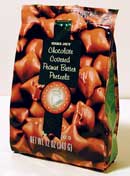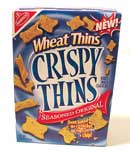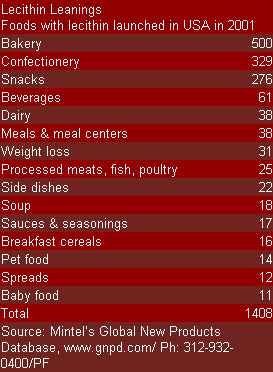
“All-natural” Choices
A “natural slimming system” is part of the description for Kellogg USA's, Battle Creek, Mich., Kashi Go Lean All Natural Frozen Waffles.The term “slimming,” popularly used in the U.K. on products for dieters, is creeping into use in the U.S. Perhaps it carries the message of “lowfat” or “diet,” without invoking the lower sensory quality with which such products often are associated.
The waffles, in original and blueberry varieties, provide “8g of protein and 6g of fiber without hydrogenated oils, high fructose corn syrup, or highly refined sugars.” The 9-oz. boxes retail for about $2.59.
The ingredient statement of the “all-natural” product showcases a careful selection of good-for-you and functional ingredients in the “original” variety: water, wheat flour, whole wheat flour, soy protein isolate, evaporated cane juice, red wheat bran, oat fiber, expeller pressed canola oil, chicory root fiber, Kashi seven whole grains & sesame flour (stone ground whole: oats, long grain brown rice, rye, hard red winter wheat, triticale, buckwheat, barley, sesame seeds), baking powder (baking soda, sodium acid pyrophosphate, monocalcium phosphate), natural flavors, soy lecithin, egg white powder, whey powder.
Lecithin has been used in baked goods probably longer than any other emulsifier. In lower-fat products, emulsifiers, in general, assist by possessing fat-like properties, including their dispersing effects, hydration and water-binding abilities. They function, in part, by dispersing and reducing the size of the fat globules that are present.
“Lecithin” fits well into the ingredient statement of all-natural products. The functionality of lecithin can be altered or improved for some applications by physically fractionating the crude lecithin into various components, or by enzymatically altering the molecule.
For example, monoglyceride emulsifiers are effective anti-staling ingredients in baked goods when their fatty acid chain moves inside the helical structure of a starch amylose molecule. Similarly, when one of the fatty acids of lecithin is removed—leaving one remaining—the modified lecithin also can assist with preventing the retrogradation of amylose molecules, and thus reducing staling.
www.kelloggs.com

(Non)-Bloomin' Chocolate
Lecithin often is found in chocolate confectionery. In confectionery coatings, emulsifiers work to inhibit “bloom,” the migration of fat onto the surface of product, resulting in a thin, whitish-appearing layer.Trader Joe's, Monrovia, Calif., just launched Chocolate Covered Peanut Butter Pretzels. A 12-oz. foil-lined plastic bag retails for $2.99. Soy lecithin is identified as one of six ingredients in the product's milk chocolate coating.
This product follows on the heels of a similar, non-chocolate-coated product by Nestlé USA, Glendale, Calif. That company rolled out Peanut Butter Pretzel Flipz in late spring of this year. The product sports the Rold Gold logo and a statement that the product is “peanut butter fudge covered pretzels” on the package. The coating contains (among other things), partially defatted ground roasted peanuts, skim milk, corn syrup, salt, less than 1.5% hydrogenated palm oil, milkfat, and soy lecithin. A 7.05-oz. bag retails for $0.75.
www.traderjoes.com

Crispy Thins
Oven-baked like a cracker but crispy like a chip.” Nabisco, East Hanover, N.J., is introducing Wheat Thins Crispy Thins in Ranch and Seasoned original flavors this fall. The snacks retail in an 8.5-oz. box for $2.39 in supermarkets nationwide.The “soy lecithin (emulsifier)” found on its label is a mainstay in many Nabisco savory crackers. Also this fall, Nabisco launched the following soy lecithin-containing products:
- Ritz Cheese Sandwich Crackers in Malaysia, designated “halal' (suitable for Muslim consumption),
-
Repackaged Ritz crackers (Original, Cheese, and 50% Less Fat) using the “Nabisco” name and a new global “bulls-eye” logo (products previously sold under the “Lanes” brand) and
-
Nabisco Pacific sesame-flavored crackers in China that are “rich in calcium and vitamin D.”
www.nabiscoworld.com/wheatthins/

Catering Comfort
Consumers increasingly are interested in comfort foods. This trend manifests itself in high-end restaurants offering meatloaf and mashed potatoes, as well as retail products that have a definite “down home” twist.Examples of the latter can be see in Nestlé USA's, Glendale, Calif., Stouffer's Family Style Recipes.
This summer, the company introduced three new frozen entrees: Chicken Cordon Bleu Pasta with chunks of chicken and ham in a cream sauce with Swiss and parmesan cheese; Potato Pot Roast Bake containing beef pieces and garden vegetables in a rich gravy topped with whipped potatoes; and last but not least, Thanksgiving Tonight with mashed potatoes, turkey, and stuffing in a rich gravy. (What's more comforting than a Thanksgiving dinner?) One 37-oz. box contains four servings and retails for about $6.33.
A close look at the ingredients in the Potato Pot Roast Bake turns up soy lecithin in a margarine component. Lecithin can play a multifunctional role in such spreads, where it helps maintain the water-in-oil emulsion. Additionally, it can assist as an anti-spatter agent, particularly in low-salt products.
Lecithin also can benefit frozen foods by improving the “release” of food components from packaging materials, and also from other components.
www.stouffers.com

Sidebar
In 2001, some 1,408 new products were tallied that declared lecithin on their label (virtually all in the ingredient statement).Lecithin molecules are amphilphilic and thus are emulsifiers for both water-in-oil and oil-in-water dispersions. The lipid portion of a molecule orients/dissolves itself in the fat or oil phase, the hydrophilic (water-loving) portion in the aqueous phase.
The broadly defined bakery category was the most frequent user of lecithin.
Lecithin goes beyond its usual emulsification function in products such as sugary frostings and fillings to help reduce sugar crystallization. It also may aid in moisture retention. In bakery mixes and other baked goods, it can be used to replace, or at least reduce, the egg yolk requirement. And, in pudding-type fillings, it can contribute to a thicker texture, enhance smoothness and reduce syneresis or water separation.
In powdered beverages, it helps disperse the various ingredients. Lecithin serves this function in products such as dry soup mixes, also.
To increase dispersion of powders, some manufacturers combine lecithin with agglomeration. In agglomeration, fine particles are aggregated together in such a manner that liquids are drawn into channels between the dry particles, creating a wetting action.
In another tactic, modified lecithins in liquid form can be added to powders during spray drying, or sprayed over dry mixes being pulverized or tumbled in mixers.
In the tally of lecithin use in the chart, several canned soups contained lecithin. However, a closer look at ingredient legends revealed the emulsifier was included as an ingredient in a margarine component.

Sidebar: Going Global
Crude lecithin—whether from soy, corn, canola, rice or other oils—is composed of a variety of compounds. Some of these components—such as tocopherol or vitamin E—possess significant nutritional benefits. The emulsifying phospholipid portion of lecithin contains phosphatidylcholine, phosphatidylsterine and other phospholipids. These molecules have been used for health purposes as well, most often as dietary supplements.
South Korea's Ildong Food's baby formula under the Foodis Akimeal Choice 1 brand contains a lengthy ingredient legend and an even lengthier nutritional breakdown. The latter contains such emerging nutritionals as lactoferrin (10mg), DHA (30mg), taurine (30mg), several other omega-3 fatty acids, and phosphatidylcholine (50mg), sphingomyelin (2.3mg) and phosphatidylethanolamine (50mg).

www.ildongfoodis.co.kr
www.solgar.com
http://www.healthwell.com/healthnotes/Supp/Lecithin.cfm
 Claudia Dziuk O'Donnell is Chief Editor and Associate Publisher of Prepared Foods magazine including its NutraSolutions and Culinary sections. Her responsibilities include determining the editorial content of the print publication and the New Products Conference.
Claudia Dziuk O'Donnell is Chief Editor and Associate Publisher of Prepared Foods magazine including its NutraSolutions and Culinary sections. Her responsibilities include determining the editorial content of the print publication and the New Products Conference.